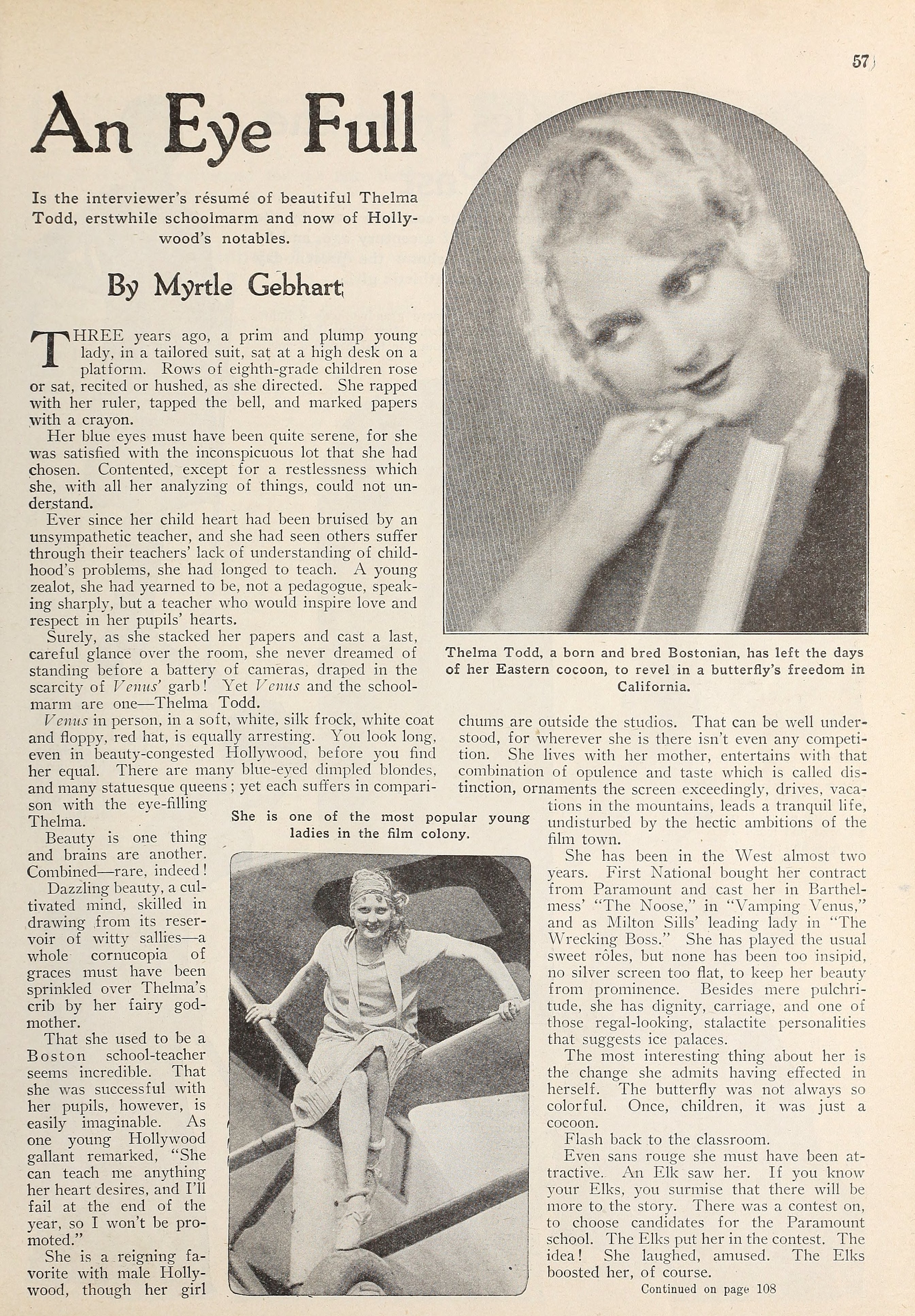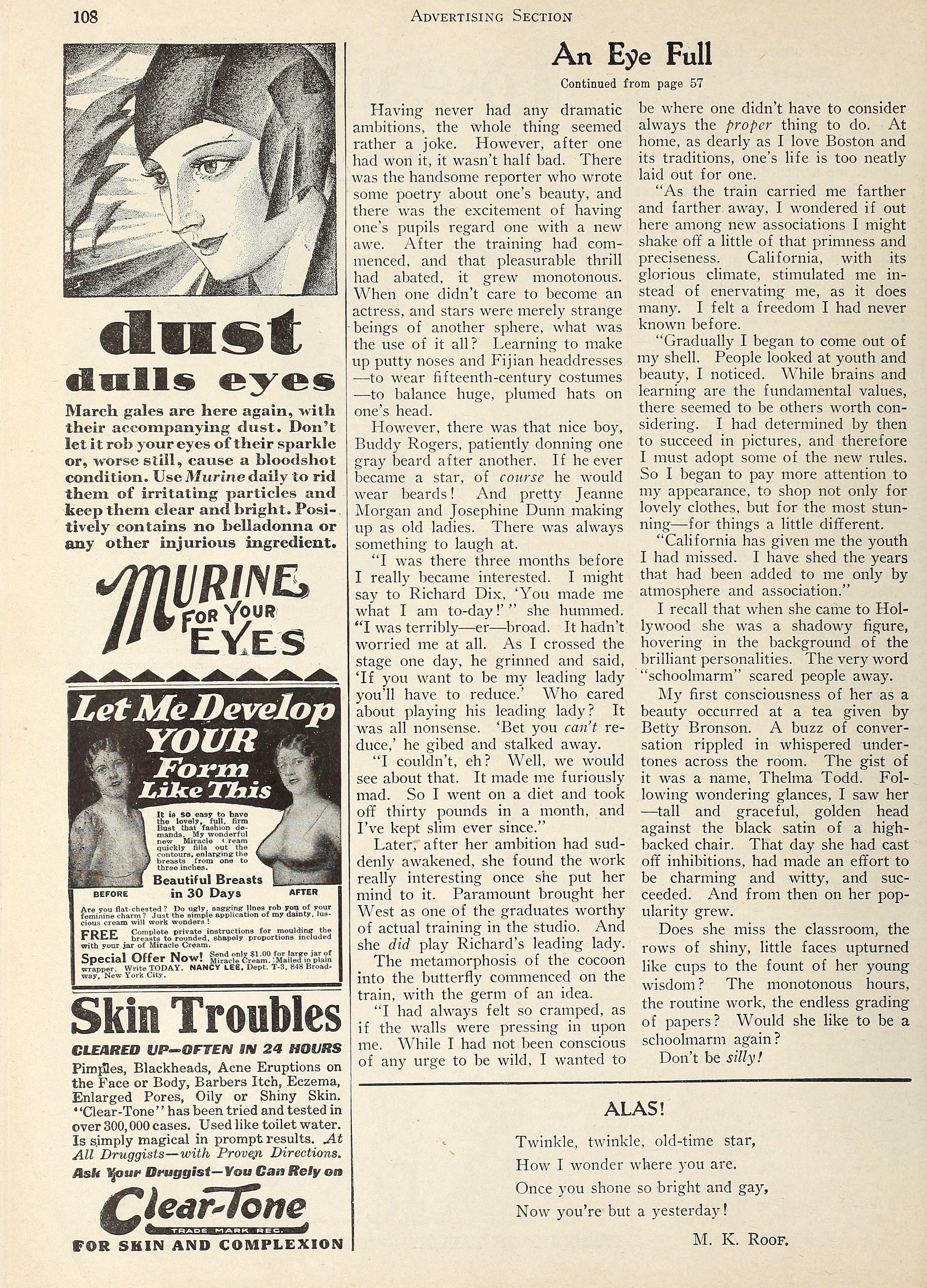Thelma Todd — An Eye Full (1929) 🇺🇸

Three years ago, a prim and plump young lady, in a tailored suit, sat at a high desk on a platform. Rows of eighth-grade children rose or sat, recited or hushed, as she directed. She rapped with her ruler, tapped the bell, and marked papers with a crayon.
by Myrtle Gebhart
Her blue eyes must have been quite serene, for she was satisfied with the inconspicuous lot that she had chosen. Contented, except for a restlessness which she, with all her analyzing of things, could not understand.
Ever since her child heart had been bruised by an unsympathetic teacher, and she had seen others suffer through their teachers’ lack of understanding of childhood’s problems, she had longed to teach. A young zealot, she had yearned to be, not a pedagogue, speaking sharply, but a teacher who would inspire love and respect in her pupils’ hearts.
Surely, as she stacked her papers and cast a last, careful glance over the room, she never dreamed of standing before a battery of cameras, draped in the scarcity of Venus’ garb! Yet Venus and the schoolmarm are one — Thelma Todd.
Venus in person, in a soft, white, silk frock, white coat and floppy, red hat, is equally arresting. You look long, even in beauty-congested Hollywood, before you find her equal. There are many blue-eyed dimpled blondes, and many statuesque queens; yet each suffers in comparison with the eye-filling Thelma.
Beauty is one thing and brains are another. Combined — rare, indeed!
Dazzling beauty, a cultivated mind, skilled in drawing from its reservoir of witty sallies — a whole cornucopia of graces must have been sprinkled over Thelma’s crib by her fairy god-mother.
That she used to be a Boston school-teacher seems incredible. That she was successful with her pupils, however, is easily imaginable. As one young Hollywood gallant remarked, “She can teach me anything her heart desires, and I’ll fail at the end of the year, so I won’t be promoted.”
She is a reigning favorite with male Hollywood, though her girl chums are outside the studios. That can be well understood, for wherever she is there isn’t even any competition. She lives with her mother, entertains with that combination of opulence and taste which is called distinction, ornaments the screen exceedingly, drives, vacations in the mountains, leads a tranquil life, undisturbed by the hectic ambitions of the film town.
She has been in the West almost two years. First National bought her contract from Paramount and cast her in Barthelmess’ The Noose, in Vamping Venus, and as Milton Sills’ leading lady in The Wrecking Boss. She has played the usual sweet roles, but none has been too insipid, no silver screen too flat, to keep her beauty from prominence. Besides mere pulchritude, she has dignity, carriage, and one of those regal-looking, stalactite personalities that suggests ice palaces.
The most interesting thing about her is the change she admits having effected in herself. The butterfly was not always so colorful. Once, children, it was just a cocoon.
Flash back to the classroom. Even sans rouge she must have been attractive. An Elk saw her. If you know your Elks, you surmise that there will be more to the story. There was a contest on, to choose candidates for the Paramount school. The Elks put her in the contest. The idea! She laughed, amused. The Elks boosted her, of course.
Having never had any dramatic ambitions, the whole thing seemed rather a joke. However, after one had won it, it wasn’t half bad. There was the handsome reporter who wrote some poetry about one’s beauty, and there was the excitement of having one’s pupils regard one with a new awe. After the training had commenced, and that pleasurable thrill had abated, it grew monotonous. When one didn’t care to become an actress, and stars were merely strange beings of another sphere, what was the use of it all? Learning to make up putty noses and Fijian headdresses — to wear fifteenth-century costumes — to balance huge, plumed hats on one’s head.
However, there was that nice boy, Buddy Rogers, patiently donning one gray beard after another. If he ever became a star, of course he would wear beards! And pretty Jeanne Morgan and Josephine Dunn making up as old ladies. There was always something to laugh at.
“I was there three months before I really became interested. I might say to Richard Dix, ‘You made me what I am to-day!’” she hummed. “I was terribly — er — broad. It hadn’t worried me at all. As I crossed the stage one day, he grinned and said, ‘If you want to be my leading lady you’ll have to reduce.’ Who cared about playing his leading lady? It was all nonsense. ‘Bet you can’t reduce,’ he gibed and stalked away.
“I couldn’t, eh? Well, we would see about that. It made me furiously mad. So I went on a diet and took off thirty pounds in a month, and I’ve kept slim ever since.”
Later, after her ambition had suddenly awakened, she found the work really interesting once she put her mind to it. Paramount brought her West as one of the graduates worthy of actual training in the studio. And she did play Richard’s leading lady.
The metamorphosis of the cocoon into the butterfly commenced on the train, with the germ of an idea.
“I had always felt so cramped, as if the walls were pressing in upon me. While I had not been conscious of any urge to be wild, I wanted to be where one didn’t have to consider always the proper thing to do. At home, as dearly as I love Boston and its traditions, one’s life is too neatly laid out for one.
“As the train carried me farther and farther away, I wondered if out here among new associations I might shake off a little of that primness and preciseness. California, with its glorious climate, stimulated me instead of enervating me, as it does many. I felt a freedom I had never known before.
“Gradually I began to come out of my shell. People looked at youth and beauty, I noticed. While brains and learning are the fundamental values, there seemed to be others worth considering. I had determined by then to succeed in pictures, and therefore I must adopt some of the new rules. So I began to pay more attention to my appearance, to shop not only for lovely clothes, but for the most stunning — for things a little different.
“California has given me the youth I had missed. I have shed the years that had been added to me only by atmosphere and association.”
I recall that when she came to Hollywood she was a shadowy figure, hovering in the background of the brilliant personalities. The very word “schoolmarm” scared people away.
My first consciousness of her as a beauty occurred at a tea given by Betty Bronson. A buzz of conversation rippled in whispered undertones across the room. The gist of it was a name, Thelma Todd. Following wondering glances, I saw her — tall and graceful, golden head against the black satin of a high-backed chair. That day she had cast off inhibitions, had made an effort to be charming and witty, and succeeded. And from then on her popularity grew.
Does she miss the classroom, the rows of shiny, little faces upturned like cups to the fount of her young wisdom? The monotonous hours, the routine work, the endless grading of papers? Would she like to be a schoolmarm again?
Don’t be silly!

She is one of the most popular young ladies in the film colony.
Thelma Todd, a born and bred Bostonian, has left the days of her Eastern cocoon, to revel in a butterfly’s freedom in California.

Collection: Picture Play Magazine, March 1929
